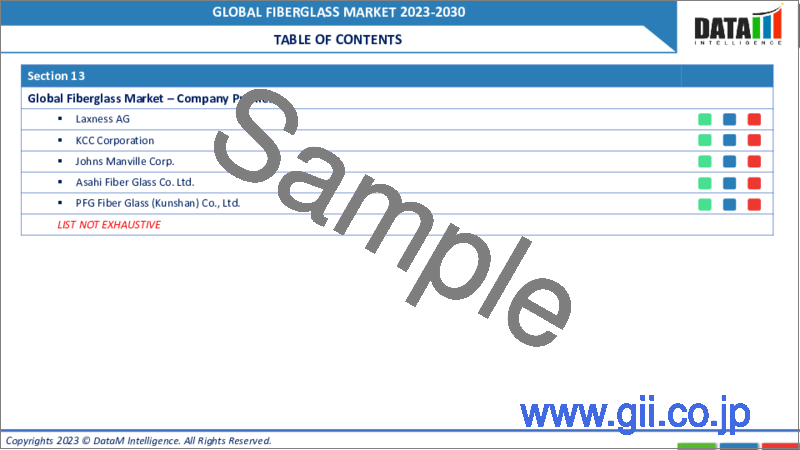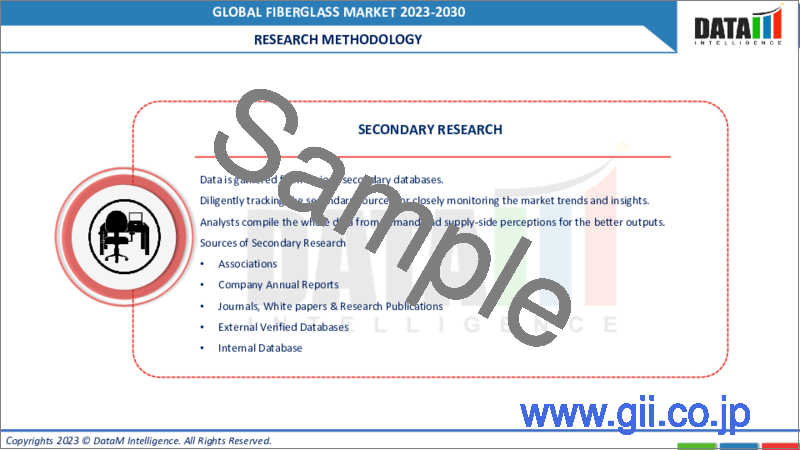|
|
市場調査レポート
商品コード
1290421
グラスファイバーの世界市場-2023-2030Global Fiberglass Market - 2023-2030 |
||||||
カスタマイズ可能
適宜更新あり
|
|||||||
| グラスファイバーの世界市場-2023-2030 |
|
出版日: 2023年06月12日
発行: DataM Intelligence
ページ情報: 英文 195 Pages
納期: 即日から翌営業日
|
- 全表示
- 概要
- 目次
市場概要
グラスファイバーの世界市場は、2022年に176億米ドルに達し、2030年には最大260億米ドルに達することで有利な成長を示すと予測されています。同市場は、予測期間2023年から2030年にかけてCAGR5.0%で成長しています。
世界のグラスファイバー市場は、建設、自動車、航空宇宙、風力エネルギー、海洋など、さまざまな分野で重要な役割を果たす盛んな産業です。建設業界からの需要の増加は、世界のグラスファイバー市場成長の主な促進要因の一つとなっています。原材料の価格変動は、グラスファイバーの世界市場の成長を阻害する主要因となっています。
市場力学
世界の建設産業の成長
建設業はグラスファイバー市場の主要な促進要因です。インフラ整備、住宅建設、商業プロジェクトに注目が集まっていることが、グラスファイバー製品の需要を後押ししています。グラスファイバーは、断熱材、屋根材、パイプ、壁パネル、コンクリート構造物の補強材などに幅広く使用されています。エネルギー効率の高い建物や持続可能な建設方法へのニーズは、グラスファイバーの断熱材やその他の建設関連アプリケーションの需要をさらに増大させます。
再生可能エネルギー導入の増加
再生可能エネルギー分野、特に風力エネルギーは、グラスファイバー材料の需要に大きく寄与しています。グラスファイバー複合材料は、風力タービンブレードの製造に使用されています。グラスファイバーの軽量かつ高強度な特性は、風力エネルギーを効率的に利用できる長くて丈夫な風力タービンブレードの建設に理想的な材料です。
クリーンで持続可能なエネルギー源への需要が高まる中、風力エネルギー分野の成長が世界のグラスファイバー市場の発展を牽引しています。
COVID-19の影響分析
グラスファイバーの世界市場は、COVID-19のパンデミックにより衰退を経験しました。しかし、このパンデミックは市場の長期的な成長に影響を与えないと予想されます。COVID-19の分析には、Pre-COVIDシナリオ、COVIDシナリオ、Post-COVIDシナリオのほか、価格力学(パンデミック時およびパンデミック後の価格変動を含む、COVID以前のシナリオとの比較)、需要-供給スペクトラム(取引制限、ロックダウンおよびその後の問題による需要と供給のシフト)、政府の取り組み(政府機関による市場、セクター、産業の再生への取り組み)、メーカー戦略的取り組み(COVID問題を軽減するためにメーカーは何を行ったかがここで取り上げられます)。
ロシア・ウクライナ戦争影響分析
ロシア・ウクライナ戦争は、世界のグラスファイバー市場に測定可能な影響を及ぼしました。紛争は、特にファイバーグラスの生産に使用される原材料のサプライチェーンを混乱させました。
ウクライナは、珪砂のような鉱物やグラスファイバー製造に不可欠な他の材料の重要な世界的サプライヤーです。この地域の混乱は、欠品や価格変動につながり、世界のグラスファイバー市場の原材料の全体的な利用可能性とコストに影響を与える可能性があります。
目次
第1章 調査手法とスコープ
- 調査手法
- 調査目的および調査範囲
第2章 定義と概要
第3章 エグゼクティブサマリー
第4章 市場力学
- 影響要因
- 促進要因
- 世界の建設業界の成長
- 再生可能エネルギー導入の増加
- 抑制要因
- 原材料の価格変動
- 機会
- 影響分析
- 促進要因
第5章 産業分析
- ポーターのファイブフォース分析
- サプライチェーン分析
- 価格分析
- 法規制の分析
第6章 COVID-19の分析
第7章 製品別
- グラスウール
- ダイレクト&アセンブルロービング
- ヤーン
- チョップドストランド
- その他
第8章 ガラスの種類別
- Sガラス
- Eガラス
- Cガラス
- Ecrガラス
- Arガラス
- Aガラス
- その他
第9章 用途別
- プラスチック
- 洗浄剤
- 樹脂
- 合成繊維
- 染料
- 殺虫剤・医薬品
- その他
第10章 地域別
- 北米
- 米国
- カナダ
- メキシコ
- 欧州
- ドイツ
- 英国
- フランス
- スペイン
- イタリア
- その他欧州
- 南米
- ブラジル
- アルゼンチン
- その他南米地域
- アジア太平洋地域
- 中国
- インド
- 日本
- オーストラリア
- その他アジア太平洋地域
- 中東・アフリカ地域
第11章 競合情勢
- 競合シナリオ
- 市況ポジショニング/シェア分析
- M&A(合併・買収)分析
第12章 企業プロファイル
- China Jushi Co., Ltd
- 会社概要
- 製品ポートフォリオと説明
- 財務概要
- 主な発展状況
- Owens Corning
- PPG Industries, Inc.
- Chongqing Polycomp International Corp.(CPIC)
- Nippon Electric Glass Co., Ltd.
- Binani 3B-The Fibreglass Company
- Taiwan Glass Ind. Corp.
- Johns Manville Corp.
- PFG Fiber Glass(Kunshan)Co., Ltd.
- Asahi Fiberglass Co., Ltd.
第13章 付録
Market Overview
The Global Fiberglass Market reached US$ 17.6 billion in 2022 and is projected to witness lucrative growth by reaching up to US$ 26 billion by 2030. The market is growing at a CAGR of 5.0% during the forecast period 2023-2030.
The Global Fiberglass Market is a thriving industry that plays a crucial role in various sectors, including construction, automotive, aerospace, wind energy, and marine. The increasing demand from the construction industry is one of the main drivers of Global Fiberglass Market growth. The volatile prices of raw materials are a key factor in inhibiting the growth of the Global Fiberglass Market.
Market Dynamics
Growth Of The Global Construction Industry
The construction sector is a major driver of the fiberglass market. The increasing focus on infrastructure development, residential construction, and commercial projects fuels the demand for fiberglass products. Fiberglass is extensively used in insulation, roofing, pipes, wall panels, and reinforcement for concrete structures. The need for energy-efficient buildings and sustainable construction practices further amplifies the demand for fiberglass insulation and other construction-related applications.
Rising Adoption of Renewable Energy
The renewable energy sector, particularly wind energy, significantly contributes to the demand for fiberglass materials. Fiberglass composites are used in the production of wind turbine blades. The lightweight and high-strength properties of fiberglass make it an ideal material for constructing long and durable wind turbine blades that can efficiently harness wind energy.
As the demand for clean and sustainable energy sources increases, the growth of the wind energy sector drives the development of the Global Fiberglass Market.
COVID-19 Impact Analysis
The Global Fiberglass Market experienced a decline due to the COVID-19 pandemic. However, the pandemic is not expected to impact the market's long-term growth. The COVID-19 Analysis includes Pre-COVID Scenario, COVID Scenario and Post-COVID Scenario along with Pricing Dynamics (Including pricing change during and post-pandemic comparing it with pre-COVID scenarios), Demand-Supply Spectrum (Shift in demand and supply owing to trading restrictions, lockdown and subsequent issues), Government Initiatives (Initiatives to revive market, sector or Industry by Government Bodies) and Manufacturers Strategic Initiatives (What manufacturers did to mitigate the COVID issues will be covered here).
Russia-Ukraine War Impact Analysis
The Russia-Ukraine war has had a measurable impact on the global fiberglass market. The conflict has disrupted supply chains, particularly for raw materials used in fiberglass production.
Ukraine is a significant global supplier of minerals like silica sand and other materials essential for fiberglass manufacturing. Disruptions in the region can lead to shortages or price volatility, affecting the global fiberglass market's overall availability and cost of raw materials.
Segment Analysis
The Global Fiberglass Market is segmented based on product, glass type, application and region.
Due To Its Versatility And Excellent Properties, Glass Wool Is Leading Within the Product Segment
Glass wool has a significant share of nearly 39% in the Global Fiberglass Market. Glass wool is produced by melting glass and spinning it into fine fibers. The fibers are then collected and processed into mats, rolls, or boards, forming a soft and lightweight material. It is primarily used for thermal and acoustic insulation in buildings, industrial facilities, and HVAC (Heating, Ventilation, and Air Conditioning) systems. Glass wool has excellent fire resistance and thermal and acoustic insulation properties. Furthermore, it can be adopted in various forms.
Geographical Analysis
A Large Aviation Industry Makes North America A Key Region For The Global Fiberglass Market
The North American fiberglass market is growing at a CAGR of 4.5%. North America's aerospace and aviation sectors are globally significant, with major manufacturers, research facilities, and industry players based in the region. Fiberglass composites find extensive applications in aircraft components, including fuselages, wings, interior structures, and rotor blades. The demand for lightweight materials in the aerospace industry drives the use of fiberglass, contributing to the growth of the fiberglass market in North America.
Competitive Landscape
The major global players include: China Jushi Co., Ltd., Owens Corning, PPG Industries, Inc., Chongqing Polycomp International Corp. (CPIC), Nippon Electric Glass Co., Ltd., Binani 3B-The Fibreglass Company, Taiwan Glass Ind. Corp., Johns Manville Corp., PFG Fiber Glass (Kunshan) Co., Ltd. and Asahi Fiberglass Co., Ltd.
Why Purchase the Report?
- To visualize the Global Fiberglass Market segmentation based on product, application and region and understand key commercial assets and players.
- Identify commercial opportunities by analyzing trends and co-development.
- Excel data sheet with numerous data points of fiberglass market-level with all segments.
- PDF report consists of a comprehensive analysis after exhaustive qualitative interviews and an in-depth study.
- Product mapping available as Excel consisting of key products of all the major players.
The Global Fiberglass Market Report Would Provide Approximately 53 Tables, 54 Figures And 195 pages.
Target Audience 2023
- Manufacturers/ Buyers
- Industry Investors/Investment Bankers
- Research Professionals
- Emerging Companies
Table of Contents
1. Methodology and Scope
- 1.1. Research Methodology
- 1.2. Research Objective and Scope of the Report
2. Definition and Overview
3. Executive Summary
- 3.1. Snippet by Product
- 3.2. Snippet by Glass Type
- 3.3. Snippet by Application
- 3.4. Snippet by Region
4. Dynamics
- 4.1. Impacting Factors
- 4.1.1. Drivers
- 4.1.1.1. Growth of the global construction industry
- 4.1.1.2. Rising Adoption of Renewable Energy
- 4.1.2. Restraints
- 4.1.2.1. Volatile prices of raw materials
- 4.1.3. Opportunity
- 4.1.4. Impact Analysis
- 4.1.1. Drivers
5. Industry Analysis
- 5.1. Porter's Five Force Analysis
- 5.2. Supply Chain Analysis
- 5.3. Pricing Analysis
- 5.4. Regulatory Analysis
6. COVID-19 Analysis
- 6.1. Analysis of COVID-19
- 6.1.1. Before COVID-19 Scenario
- 6.1.2. During COVID-19 Scenario
- 6.1.3. Post COVID-19 or Future Scenario
- 6.2. Pricing Dynamics Amid COVID-19
- 6.3. Demand-Supply Spectrum
- 6.4. Government Initiatives Related to the Market During Pandemic
- 6.5. Manufacturers Strategic Initiatives
- 6.6. Conclusion
7. By Product
- 7.1. Introduction
- 7.1.1. Market Size Analysis and Y-o-Y Growth Analysis (%), By Product
- 7.1.2. Market Attractiveness Index, By Product
- 7.2. Glass Wool *
- 7.2.1. Introduction
- 7.2.2. Market Size Analysis and Y-o-Y Growth Analysis (%)
- 7.3. Direct And Assembled Roving
- 7.4. Yarn
- 7.5. Chopped Strand
- 7.6. Others
8. By Glass Type
- 8.1. Introduction
- 8.1.1. Market Size Analysis and Y-o-Y Growth Analysis (%), By Glass Type
- 8.1.2. Market Attractiveness Index, By Glass Type
- 8.2. S-Glass*
- 8.2.1. Introduction
- 8.2.2. Market Size Analysis and Y-o-Y Growth Analysis (%)
- 8.3. E-Glass
- 8.4. C-Glass
- 8.5. Ecr-Glass
- 8.6. Ar-Glass
- 8.7. A-Glass
- 8.8. Others
9. By Application
- 9.1. Introduction
- 9.1.1. Market Size Analysis and Y-o-Y Growth Analysis (%), By Application
- 9.1.2. Market Attractiveness Index, By Application
- 9.2. Plastics*
- 9.2.1. Introduction
- 9.2.2. Market Size Analysis and Y-o-Y Growth Analysis (%)
- 9.3. Detergents
- 9.4. Resins
- 9.5. Synthetic Fibers
- 9.6. Dyes
- 9.7. Pesticides & Drugs
- 9.8. Others
10. By Region
- 10.1. Introduction
- 10.1.1. Market Size Analysis and Y-o-Y Growth Analysis (%), By Region
- 10.1.2. Market Attractiveness Index, By Region
- 10.2. North America
- 10.2.1. Introduction
- 10.2.2. Key Region-Specific Dynamics
- 10.2.3. Market Size Analysis and Y-o-Y Growth Analysis (%), By Product
- 10.2.4. Market Size Analysis and Y-o-Y Growth Analysis (%), By Glass Type
- 10.2.5. Market Size Analysis and Y-o-Y Growth Analysis (%), By Application
- 10.2.6. Market Size Analysis and Y-o-Y Growth Analysis (%), By Country
- 10.2.6.1. The U.S.
- 10.2.6.2. Canada
- 10.2.6.3. Mexico
- 10.3. Europe
- 10.3.1. Introduction
- 10.3.2. Key Region-Specific Dynamics
- 10.3.3. Market Size Analysis and Y-o-Y Growth Analysis (%), By Product
- 10.3.4. Market Size Analysis and Y-o-Y Growth Analysis (%), By Glass Type
- 10.3.5. Market Size Analysis and Y-o-Y Growth Analysis (%), By Application
- 10.3.6. Market Size Analysis and Y-o-Y Growth Analysis (%), By Country
- 10.3.6.1. Germany
- 10.3.6.2. The UK
- 10.3.6.3. France
- 10.3.6.4. Spain
- 10.3.6.5. Italy
- 10.3.6.6. Rest of Europe
- 10.4. South America
- 10.4.1. Introduction
- 10.4.2. Key Region-Specific Dynamics
- 10.4.3. Market Size Analysis and Y-o-Y Growth Analysis (%), By Product
- 10.4.4. Market Size Analysis and Y-o-Y Growth Analysis (%), By Glass Type
- 10.4.5. Market Size Analysis and Y-o-Y Growth Analysis (%), By Application
- 10.4.6. Market Size Analysis and Y-o-Y Growth Analysis (%), By Country
- 10.4.6.1. Brazil
- 10.4.6.2. Argentina
- 10.4.6.3. Rest of South America
- 10.5. Asia-Pacific
- 10.5.1. Introduction
- 10.5.2. Key Region-Specific Dynamics
- 10.5.3. Market Size Analysis and Y-o-Y Growth Analysis (%), By Product
- 10.5.4. Market Size Analysis and Y-o-Y Growth Analysis (%), By Glass Type
- 10.5.5. Market Size Analysis and Y-o-Y Growth Analysis (%), By Application
- 10.5.6. Market Size Analysis and Y-o-Y Growth Analysis (%), By Country
- 10.5.6.1. China
- 10.5.6.2. India
- 10.5.6.3. Japan
- 10.5.6.4. Australia
- 10.5.6.5. Rest of Asia-Pacific
- 10.6. Middle East and Africa
- 10.6.1. Introduction
- 10.6.2. Key Region-Specific Dynamics
- 10.6.3. Market Size Analysis and Y-o-Y Growth Analysis (%), By Product
- 10.6.4. Market Size Analysis and Y-o-Y Growth Analysis (%), By Glass Type
- 10.6.5. Market Size Analysis and Y-o-Y Growth Analysis (%), By Application
11. Competitive Landscape
- 11.1. Competitive Scenario
- 11.2. Market Positioning/Share Analysis
- 11.3. Mergers and Acquisitions Analysis
12. Company Profiles
- 12.1. China Jushi Co., Ltd *
- 12.1.1. Company Overview
- 12.1.2. Product Portfolio and Description
- 12.1.3. Financial Overview
- 12.1.4. Key Developments
- 12.2. Owens Corning
- 12.3. PPG Industries, Inc.
- 12.4. Chongqing Polycomp International Corp. (CPIC)
- 12.5. Nippon Electric Glass Co., Ltd.
- 12.6. Binani 3B-The Fibreglass Company
- 12.7. Taiwan Glass Ind. Corp.
- 12.8. Johns Manville Corp.
- 12.9. PFG Fiber Glass (Kunshan) Co., Ltd.
- 12.10. Asahi Fiberglass Co., Ltd.
LIST NOT EXHAUSTIVE
13. Appendix
- 13.1. About Us and Services
- 13.2. Contact Us





